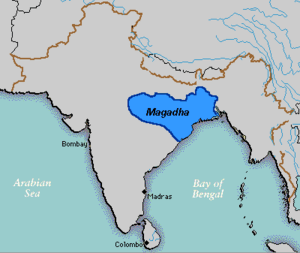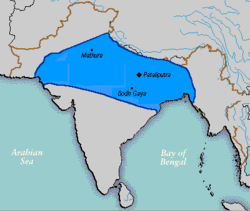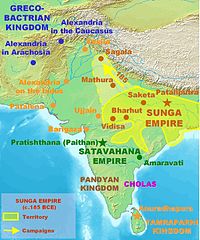Magadha


| History of South Asia |
|---|
 |
Magadha (मगध) formed one of the sixteen so-called Mahājanapadas (Sanskrit, 'great country') or regions in ancient India. The core of the kingdom was the portion of Bihar lying south of the Ganges, with its capital at Rajagriha (modern Rajgir). Magadha expanded to include Eastern Uttar Pradesh most of Bihar and Bengal with the conquest of Licchavi and Anga respectively.[1] The ancient kingdom of Magadha is mentioned in Ramayana, Mahabharata, Puranas, and heavily mentioned in Buddhist and Jaina texts. The first reference to the Magadha occurs in the Atharva-Veda where they are found listed along with the Angas, Gandharis and the Mujavats as a despised people. Two of India's major religions started from Magadha; Two of India's greatest empires, the Maurya Empire and Gupta Empire, along with others, originated from Magadha. They advanced ancient India's science, mathematics, astronomy, religion and philosophy and were considered the Indian "Golden Age". The Magadha kingdom included republican communities such as Rajakumara. Villages had their own assemblies under their local chiefs called Gramakas. Their administrations were divided into executive, judicial and military functions.
Geography
The kingdom of the Magadha roughly corresponded to the modern districts of Patna and Gaya in southern Bihar, and parts of Bengal in the east. It was bounded on the north by river Ganga, on the east by the river Champa, on the south by Vindhya mountains and on the west by river Sona. During the Buddha’s time and onward, its boundaries included Anga.
History
There is little certain information available on the early rulers of Magadha. The most important sources are the Buddhist Chronicles of Sri Lanka, the Puranas, and various other Jaina and Buddhist texts. Based on these sources, it appears that Magadha was ruled by the Śiśunāga dynasty for some 200 years, c. 550 - 350 BC. The Śiśunāga dynasty was overthrown by Ugrasena Mahāpadma Nanda, the first of the so-called nine Nandas (a.k.a. the Nanda or Nava Nanda dynasty). He was followed by his eight sons, whose names were (according to the Mahābodhivamsa) Panduka, Pandugati, Bhūtapāla, Ratthapāla, Govisānaka, Dasasiddhaka, Kevatta, and Dhana Nanda. According to the Sri Lankan Chronicles, the Nanda dynasty was in power for mere 22 years, while the Puranas state that Mahāpadma ruled for 28 years and his eight sons for only 12.
King Bimbisara of the hariyanka dynasty led an active and expansive policy, conquering Anga in what is now West Bengal.
Siddhartha Gautama himself was born a prince of Kapilavastu in Kosala around 563 BC. As the scene of many incidents in his life, Magadha was a holy land.
After the death of Bimbisara at the hands of his son, Ajatashatru, the widowed princess of Kosala also died of grief, causing King Prasenajit to revoke the gift of Kashi and triggering a war between Kosala and Magadha. Ajatashatru was trapped by an ambush and captured with his army; but in a peace treaty he, his army, and Kashi were restored to Magadha, and he married Prasenajit's daughter.
Accounts differ slightly as to the cause of Ajatashatru's war with the Licchavi republic. It appears that Ajatashatru sent a minister, who for three years worked to undermine the unity of the Licchavis at Vaishali. To launch his attack across the Ganga River (Ganges), Ajatashatru had to build a fort at a new capital called Pataliputra, which the Buddha prophesied would become a great center of commerce. Torn by disagreements the Licchavis were easily defeated once the fort was constructed. Jain texts tell how Ajatashatru used two new weapons – a catapult and a covered chariot with swinging mace that has been compared to modern tanks.
In 326 BC, the army of Alexander the Great approached the boundaries of the Magadhan Empire. The army, exhausted and frightened by the prospect of facing another giant Indian army at the Ganges River, mutinied at the Hyphasis (modern Beas) and refused to march further East. Alexander, after the meeting with his officer, Coenus, was convinced that it was better to return, and turned south, conquering his way down the Indus to the Ocean.
A short while later, Magadha was the seat of the powerful Maurya dynasty, founded by Chandragupta, which extended over most of Southern Asia under Asoka; and, later, of the powerful Gupta Empire. The capital of the Mauryan Empire, Pataliputra (modern Patna), was begun as a Magadhan fortress and became the capital sometime after Ajatashatru's reign. Chandragupta destroyed the Nanda dynasty around 321 BC, and became the first king of the great Mauryan Empire.
Magadha Dynasties
Amongst the sixteen Mahajanapadas, the kingdom of Magadha rose to prominence under a number of dynasties that peaked in power under the reign of Asoka Maurya, one of India's most legendary and famous emperors. The kingdom of Magadha had emerged as a major power following the subjugation of two neighbouring kingdoms, and possessed an unparalleled military.
Brihadratha dynasty
According to the Puranas,the Magadha Empire was established by the Brihadratha Dynasty, who was the sixth in line from Emperor Kuru of the Bharata dynasty through his eldest son Sudhanush.The first prominent Emperor of the Magadhan branch of Bharathas was Emperor Brihadratha.His son Jarasandha appears in popular legend and is slain by Bhima in the Mahabharatha.Vayu Purana mentions that the Brihadrathas ruled for 1000 years.
Pradyota dynasty
The Brihadrathas were succeeded by the Pradyotas who according to the Vayu Purana ruled for 138 years. One of Pradyota tradition was that son would kill his father to become the successor. During this time, it is reported that there was high crimes in Magadha. The people rose up and elected Shishunaga to become the new king, who destroyed the power of the Pradyotas and created the Shishunaga dynasty.
Shishunaga dynasty
According to tradition, the Shishunaga dynasty founded the Magadha Empire in 684 BC, whose capital was Rajagriha, later Pataliputra, near the present day Patna. This dynasty lasted till 424 BC, when it was overthrown by the Nanda dynasty. This period saw the development of two of India's major religions that started from Magadha. Gautama Buddha in the 6th or 5th century BC was the founder of Buddhism, which later spread to East Asia and South-East Asia, while Mahavira revived and propagated the ancient sramanic religion of Jainism.

Nanda dynasty
The Nanda dynasty was established by an illegitimate son of the king Mahanandin of the previous Shishunaga dynasty. Mahapadma Nanda died at the age of 88, ruling the bulk of this 100-year dynasty. The Nandas were followed by the Maurya dynasty.
Maurya dynasty

In 321 BC, exiled general Chandragupta Maurya founded the Maurya dynasty after overthrowing the reigning Nanda king Dhana Nanda to establish the Maurya Empire. During this time, most of the subcontinent was united under a single government for the first time. Capitalising on the destabilization of northern India by the Persian and Greek incursions, the Mauryan empire under Chandragupta would not only conquer most of the Indian subcontinent, but also push its boundaries into Persia and Central Asia, conquering the Gandhara region. Chandragupta was succeeded by his son Bindusara, who expanded the kingdom over most of present day India, barring the extreme south and east.

The only region that was not under the Mauryan's were present day Tamil Nadu and Kerala (which was a Tamil kingdom then). There are references in one of the oldest Tamil Sangam literature, Purananuru, that a Mauryan army was driven out by a unified Tamil army under the leadership of Ilanchetchenni, a Chola King. This unified Tamil force is supposed to be broken by King Kharavela, a Kalinga ruler, as per one of his inscriptions.
The kingdom was inherited by his son Ashoka The Great who initially sought to expand his kingdom. In the aftermath of the carnage caused in the invasion of Kalinga, he renounced bloodshed and pursued a policy of non-violence or ahimsa after converting to Buddhism. The Edicts of Ashoka are the oldest preserved historical documents of India, and from Ashoka's time, approximate dating of dynasties becomes possible. The Mauryan dynasty under Ashoka was responsible for the proliferation of Buddhist ideals across the whole of East Asia and South-East Asia, fundamentally altering the history and development of Asia as a whole. Ashoka the Great has been described as one of the greatest rulers the world has seen.

Sunga dynasty
The Sunga dynasty was established in 185 BC, about fifty years after Ashoka's death, when the king Brihadratha, the last of the Mauryan rulers, was assassinated by the then commander-in-chief of the Mauryan armed forces, Pusyamitra Sunga, while he was taking the Guard of Honour of his forces. Pusyamitra Sunga then ascended the throne.
Kanva dynasty
The Kanva dynasty replaced the Sunga dynasty, and ruled in the eastern part of India from 71 BC to 26 BC. The last ruler of the Sunga dynasty was overthrown by Vasudeva of the Kanva dynasty in 75 BC. The Kanva ruler allowed the kings of the Sunga dynasty to continue to rule in obscurity in a corner of their former dominions. Magadha was ruled by four Kanva rulers. In 30 BC, the southern power swept away both the Kanvas and Sungas and the province of Eastern Malwa was absorbed within the dominions of the conqueror. Following the collapse of the Kanva dynasty, the Satavahana dynasty of the Andhra kindgom replaced the Magandhan kingdom as the most powerful Indian state.
Gupta dynasty
Gupta dynasty ruled from around 240 to 550 AD. The Gupta Empire was one of the largest political and military empires in ancient India.The Gupta age is referred to as the Classical age of India by most historians.The time of the Gupta Empire was an Indian "Golden Age" in science, mathematics, astronomy, religion and philosophy.They had their capital at Pataliputra.The difference between Gupta and Mauryan administration was that the in the Mauryan administration power was centralised but in the Gupta administration power was more decentralised.The king occupied a powerful and important position and often took titles to assert his supremacy.A council of ministers and some officials helped him.The empire was divided into provinces and provinces were further divided into districts.Villages were the smallest units.The kingdom covered Gujarat,North-east India,south-eastern Pakistan,Orissa,northern Madhya Pradesh and eastern India.Art and architecture flourished during the Gupta age.People were mostly Vaishnavas.Temples devoted to Shiva and Vishnu were built during this period.Early temples had a large room where the idol of god was kept.Today these can be found in Deogarh in Jhansi.Temples were mostly made of brick or stone.The doorways were very decorative.Wall murals flourished during this age.These can be seen in Ajanta caves near Aurangabad.These murals depict the life of Buddha.Yajnas were performed by Brahmins.All forms of worship were carried out in Sanskrit.Astronomy made rapid strides.Aryabhatta and Varahamihira were two great Astronomers and Mathematicians.Aryabhatta stated that the earth moved round the sun and rotated on its own Axis.Metallurgy too made rapid strides.Proof is the Iron Pillar near Mehrauli on the outskirts of Delhi.Ayurveda was known to the people of Gupta age.People livedin a happy and prosperous life.Most people lived in villages and led a simple life.Rest houses and hospitals were set up.Laws were simple and punishments were not very harsh.However there was a serious flaw.The bad,inhuman treatment of the Chandalas or Untouchables.They were made to live outside the city and even their shadows were considered capable of polluting.The material sources of this age were Kalidasa's works i.e Raghuvamsa,Meghdoot,Malavikagnimitram and Abhinjnana Shakuntalam,works of Fa-hein,the Chinese buddhist scholar,Allahabad pillar inscription called Prayag Prashsti,Books by Harisena and others.
Kings of Magadha
Semi-legendary rulers in Purana accounts.
- Brihadratha
- Jarasandha
- Sahadeva
- Somapi (1678-1618 BC)
- Srutasravas (1618-1551 BC)
- Ayutayus (1551-1515 BC)
- Niramitra (1515-1415 BC)
- Sukshatra (1415-1407 BC)
- Brihatkarman (1407-1384 BC)
- Senajit (1384-1361 BC)
- Srutanjaya (1361-1321 BC)
- Vipra (1321-1296 BC)
- Suchi (1296-1238 BC)
- Kshemya (1238-1210 BC)
- Subrata (1210-1150 BC)
- Dharma (1150-1145 BC)
- Susuma (1145-1107 BC)
- Dridhasena (1107-1059 BC)
- Sumati (1059-1026 BC)
- Subhala (1026-1004 BC)
- Sunita (1004-964 BC)
- Satyajit (964-884 BC)
- Biswajit (884-849 BC)
- Ripunjaya (849-799 BC)
Ruling 799-684 BC according to calculations based on the Vayu Purana[citation needed].
- Pradyota
- Palaka
- Visakhayupa
- Ajaka
- Varttivarddhana
Hariyanka dynasty (545 BC-346 BC) and Shishunaga dynasty (430-364 BC)
- Bimbisara (545-493 BC), founder of the first Magadhan empire[2][3]
- Ajatashatru (493-461 BC)
- Darshaka (from 461 BC)
- Udayin
- Shishunaga (430 BC), established the kingdom of Magadha
- Kakavarna (394-364 BC)
- Kshemadharman (618-582 BC)
- Kshatraujas (582-558 BC)
- Nandivardhana
- Mahanandin (until 424 BC), his empire is inherited by his illegitimate son Mahapadma Nanda
Nanda Dynasty (424-321 BC)
- Mahapadma Nanda (from 424 BC), illegitimate son of Mahanandin, founded the Nanda Empire after inheriting Mahanandin's empire
- Pandhuka
- Panghupati
- Bhutapala
- Rashtrapala
- Govishanaka
- Dashasidkhaka
- Kaivarta
- Dhana (Agrammes, Xandrammes) (until 321 BC), lost his empire to Chandragupta Maurya after being defeated by him
Maurya Dynasty (324-184 BC)
- Chandragupta Maurya (Sandrakottos) (324-301 BC), founded the Mauryan Empire after defeating both the Nanda Empire and the Macedonian Seleucid Empire, claimed descent from Shakya dynasty
- Bindusara Amitraghata (301-273 BC)
- Ashoka Vardhana (Ashoka the Great) (273-232 BC), considered the greatest ancient Indian emperor, first emperor to unify India (after conquering most of South Asia and Afghanistan), adopt Buddhism, grant animal rights and promote non-violence
- Dasaratha (232-224 BC)
- Samprati (224-215 BC)
- Salisuka (215-202 BC)
- Devavarman (202-195 BC)
- Satadhanvan (195-187 BC), the Mauryan Empire had shrunk by the time of his reign
- Brhadrata (187-184 BC), assassinated by Pusyamitra Shunga
Shunga Dynasty (185-73 BC)
- Pusyamitra Shunga (185-149 BC), founded the dynasty after assassinating Brhadrata
- Agnimitra (149-141 BC), son and successor of Pusyamitra
- Vasujyeshtha (141-131 BC)
- Vasumitra (131-124 BC)
- Andhraka (124-122 BC)
- Pulindaka (122-119 BC)
- Ghosha
- Vajramitra
- Bhagabhadra, mentioned by the Puranas
- Devabhuti (83-73 BC), last Sunga king
Kanva Dynasty (73-26 BC)
- Vasudeva (from 73 BC)
- Successors of Vasudeva (until 26 BC)
Gupta Dynasty (c. 240-550 AD)
- Sri-Gupta I (c. 240-290)
- Ghatotkacha (290-305)
- Chandra Gupta I (305-335), founder of the Gupta Empire, which is often regarded as the golden age of Indian culture
- Samudra Gupta (335-370)
- Rama Gupta (370-375)
- Chandra Gupta II (Chandragupta Vikramaditya) (375-415), son of Samudra Gupta, the Gupta Empire achieved its zenith under his reign, the Chinese pilgrim Fa-Hsien describes Indian culture during his reign
- Kumara Gupta I (415-455)
- Skanda Gupta (455-467)
- Kumara Gupta II (467-477)
- Buddha Gupta (477-496)
- Chandra Gupta III (496-500)
- Vainya Gupta (500-515)
- Narasimha Gupta (510-530)
- Kumara Gupta III (530-540)
- Vishnu Gupta (c. 540-550)
References
- ^ Ramesh Chandra Majumdar (1977). Ancient India. Motilal Banarsidass Publ. ISBN 8120804368.
- ^ Rawlinson, Hugh George. (1950) A Concise History of the Indian People, Oxford University Press. p. 46.
- ^ Muller, F. Max. (2001) The Dhammapada And Sutta-nipata, Routledge (UK). p. xlvii. ISBN 0-7007-1548-7.
